When you farm in the North-East of Scotland, “drought” isn’t a word we use often; we’re more likely to be complaining about wet weather pushing cereal harvest into October, than parched soils.
Yet the weather patterns of the last few years are a different story: the extended dry over the spring and early summer, interspersed with spells of intense heavy rain or high winds.
Earlier this week – unsurprisingly – SEPA announced ‘moderate scarcity’ of water in the Spey, Deveron, Ythan, Don, Esk, the Firth of Tay and Tyne, the Almond and the Tweed. In their statement they said that these areas have received 40% less rainfall compared to the long-term average. Added concern of prolonged dryness on groundwater reserves could see homes and farms in northern and eastern Scotland run dry.
I’ve seen first-hand what prolonged drought really means. Having worked and lived on a farm near Esperance in Western Australia and later travelling to north-west Queensland at the height of their five-year drought in 2015, I witnessed the deep impact of no water on farming decisions and practices. Adaptation wasn’t a choice; it was about survival and also developing preparedness to cope better with future dry spells.
While we are very unlikely to experience what Australia does, the parallels did make me reflect on what we can learn from farmers in other countries and regions. How they prepare and mitigate the consequences of limited or no rain.
Last year I met a farmer from Romania, he’s called Avram Razvan, he’s seen summer rainfall more than halve in the past 20 years. To cope, he’s diversified into broiler production, planted drought-tolerant crops, and, at harvest, he just cuts the head of his cereal crop to allow the standing straw to protect the moisture in his soils and sustain some germination of a volunteer crop – from shed grain – for his sheep to graze over winter.
More routinely, farmers like Avram have adjusted sowing dates, drilling earlier in the spring to capture moisture while it’s still there and planting deep-rooted cover crops that help store winter rainfall and release it later in the season.
In the east of England, dryland farmers have invested in on-farm reservoirs and water capture systems, as well as permanent irrigation loops for vegetable growing. It’s a big capital investment, but it gives them control when dry spells hit, while maintaining the business benefit of growing carrots, salads and early potatoes on their sandy soils. We don’t face the same extremes in Aberdeenshire or Moray, but as water abstraction rules tighten, small-scale storage could become part of our own regional resilience.
And all over the world, where I’ve seen that drought is just part of life, farmers focus relentlessly on soil cover with vegetation. Bare ground is the enemy. Stubble, mulches, or cover crops are always left in place to reduce evaporation and hold on to precious moisture. It’s a lesson that could apply just as well to sandy soils in Buchan or Moray as it does to the rich, red earth in New South Wales.
Of course, Scotland isn’t about to become Norfolk or Australia overnight. But it would be a mistake to dismiss drought as neverland. This year is a reminder of how the weather can challenge even the most water resilient of places.
Maybe it’s time to ask ourselves some tough questions. Could we store winter rainfall through storage or better soil management? Should we do more to make the most of winter accumulated soil moisture? Should alternative enterprises be part of a deliberate resilience plan? And vitally, do we need to value and preserve water more?
For generations Scottish farmers have adapted to climate, historically dealing with too much water. The challenge ahead may be less about too much, but rather too little. We don’t yet live in a droughted region, but heeding what others do might give us the flexibility when the rain fails to fall.
